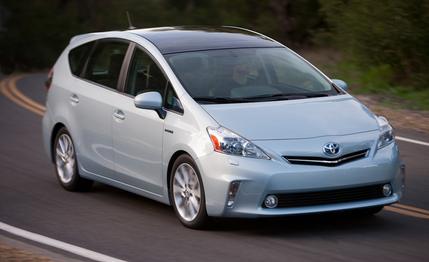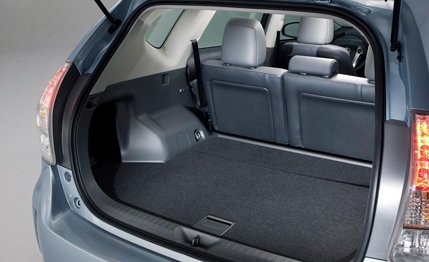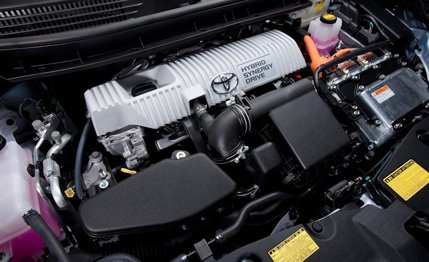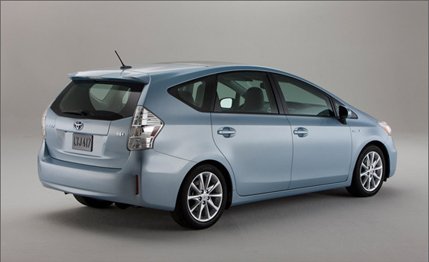
 First Drive Review
First Drive Review


Since 1997, more than two million Toyota Prius hybrids have been sold in 70 countries. Loosely translated, the Latin word prius means “ahead of the curve,” not “creep along in the passing lane” as some owners seem to believe. The U.S. is the single largest Prius market with more than a million purchased here since 2000. The Prius currently outsells 30 other U.S.-market hybrids combined.
Refuting early powertrain-complexity and battery-life scares, more than 97 percent of the Priuses produced are still on the road. Used battery packs are available from salvage yards for around $500.
Born a compact fuel-squeezer and penny-pincher, Prius advanced to the mid-size class in 2003. That second-generation model earned wide acclaim, including a spot on our 2004 10Best list.


Toyota’s U.S. general manager, Bob Carter, has high hopes that a growing Prius family will eventually surpass the sales volumes of the Camry and Corolla cash cows. And here is the first of the basic hatchback’s descendants, the Prius V. (That’s pronounced “vee” and not “five.”)
The V badge distinguishing the second Prius arriving this fall supposedly is meant to imply “versatile,” but it might just as well be Toyota’s victory salute. A risky engineering experiment worked, the Prius badge is universally recognized as the king of gas-electrics, and the hybrid pixie dust is being sprinkled over the 2012 V and two additional Prius models arriving next year.
Instead of simply flattening the roof and enlarging the standard Prius’s hatch to create the V, Toyota engineers went the extra mile. Their all-new body fits between conventional wagons, minivans, and compact crossovers. Size-wise, it’s a Mazda 5 with no third-row seating. (Other markets will get a three-row version of the V called the Prius+ or Alpha) Unlike the Chevy Volt and Nissan Leaf’s lithium-ion setups, the battery pack uses cheaper but still effective nickel-metal hydride cells. Carrying a richer load of standard and optional equipment, the Prius V likely will arrive with prices ranging from $25,000 to $35,000. This is among the first vehicles to get Toyota’s new Entune infotainment system.


The V’s core carry-over from the regular Prius is Toyota’s Hybrid Synergy Drive system. Two electric motors and a 1.8-liter four-cylinder engine deliver a combined 134 hp through a final-drive ratio changed from the standard Prius’s 3.27:1 to 3.70:1. The larger frontal area and 232 pounds of additional weight stretch the run to 60 mph to more than 10 seconds. Estimated combined-driving gas mileage falls from 50 to a still-impressive 42 mpg.
The Prius V’s principal attraction is the three-cubic-foot gain in passenger volume and the 70-percent increase in maximum cargo space provided by its 3.0-inch longer wheelbase, 6.0-inch gain in overall length, and 1.1-inch width increase. A maximum of 34 cubes of stuff will fit behind the second row, and 67 can be accommodated with those seats folded. Extra-long rear doors—we foresee problems in parking lots and plenty of V-inflicted dings—and a roof raised by 3.3 inches provide ready access to back seats that slide 7.1 inches and fold on a 60/40 split. The second-row backrests adjust 45 degrees.
The V’s structure is sound, shrewdly tuned dampers do a commendable job of managing body motion, and new dual-path front-strut mounts eliminate some of the standard Prius’s impact harshness. Wraparound front seatbacks hold securely during hard cornering.


Unfortunately, this is not the hybrid for hot dogs. The V’s electric power steering is nicely weighted but devoid of road feel. The A-pillars are thick obstructions. The full-throttle drone is such incessant torture that you will willingly take your place in the slow lane, where you will now blot out more of the road ahead than regular Prius drivers.
Prius fans, on the other hand, will probably consider the V’s additional space, respectable fuel economy, and new creature comforts exactly the sort of treat they deserve for their upstanding environmental stewardship.